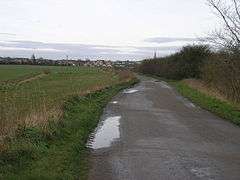Laughton-en-le-Morthen
| Laughton-en-le-Morthen | |
|---|---|
 View towards the village | |
 Laughton-en-le-Morthen Laughton-en-le-Morthen shown within South Yorkshire | |
| Population | 1,241 (2011) |
| OS grid reference | SK5288 |
| Civil parish |
|
| Metropolitan borough | |
| Metropolitan county | |
| Region | |
| Country | England |
| Sovereign state | United Kingdom |
| Post town | SHEFFIELD |
| Postcode district | S25 |
| Dialling code | 01909 |
| Police | South Yorkshire |
| Fire | South Yorkshire |
| Ambulance | Yorkshire |
| EU Parliament | Yorkshire and the Humber |
| UK Parliament | |
Laughton-en-le-Morthen is a small dormitory village and civil parish in the Metropolitan Borough of Rotherham lying to the south of Rotherham, South Yorkshire, England, and its main attraction is the All Saints Church with its huge spire. It had a population of 1,241 at the 2011 Census.[1]
History
Edwin, Earl of Mercia is believed to have built a Saxon hall in the village.[2] But after conquest of England, Roger de Busli (c. 1038 – c. 1099) was made Norman baron following the Norman conquest of England.[3][4] Busli was given lands in Nottinghamshire, Derbyshire and the Strafforth wapentake of Yorkshire. The castle he built at Laughton-en-le-Morthen is believed to stand on the site of Edwin's hall. It is a motte and bailey with a 9 m (30 ft) high mound high with a 50 m (160 ft) by 20 m (66 ft) inner bailey that was surrounded by large earthworks and an outer ditch. An outer bailey, which is now the churchyard of the 14th century All Saints parish church, also had substantial earth ramparts and a dry ditch. The castle, along with others at Tickhill, Kimberworth, and Mexborough, were among a number Busli had built in the late 11th century.[2]
By the time of the Domesday survey, Laughton-en-le-Morthen was part of Busli's extensive landholdings known as the "Honour of Blythe" that included 86 manors in Nottinghamshire, 46 in Yorkshire, and others in Derbyshire, Lincolnshire and Leicestershire, as well as one in Devon.
Modern
Laughton has two schools, the council-run Laughton Junior and Infant School, and the Laughton Church of England School, which is situated directly opposite All saints Church, whose distinctive spire is visible from Lincolnshire on a clear day, and is a local landmark dominating the area from the hill.
There are also two public houses in the village, the St Leger Arms (named after local landowners the St. Leger family) which like many other village pubs closed in 2009, and is still derelict and the Hatfeild Arms, which is also named after a well known local family.
The village sits on the main bus route from Worksop to Rotherham (19 operated by Stagecoach) and the Dinnington to Doncaster service (18 operated by Powells buses).
In the Second World War, a German bomber on his way back from a raid on Sheffield dropped an unused bomb on the village, which failed to go off; local farmer Henry Turner, whose family recently still lived in the village, towed the bomb to safety across his fields. Notable residents include Steven "Russel" Stanley, the official Bryan Adams biographer.
Sport
The village was represented in the FA Cup by Laughton Common F.C. during the 1920s.
References
- ↑ UK Census (2011). "Local Area Report – Laughton-en-le-Morthen Parish (1170221220)". Nomis. Office for National Statistics. Retrieved 12 February 2018.
- 1 2 David Hey, Medieval South Yorkshire
- ↑ François de Beaurepaire, Les noms des communes et anciennes paroisses de la sine-Maritime, éditions Picard 1979. p. 54.
- ↑ Scholars believe that the English word 'bully' derives from the surname of this early Norman lord.{cn}
External links
